Musical instrument: Harp
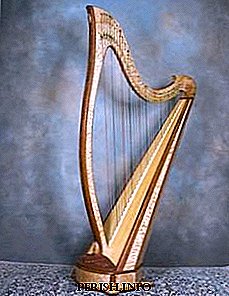
Golden strings resembling the rays of the sun ... Elegant frame, decorated with carvings and ornaments - like the wing of a huge butterfly. Noble sound and soft silver timbre ... It is not surprising that the harp is considered the most beautiful and poetic musical instrument. And still mysterious.
In ancient times, the harp was considered an instrument of the gods, in the middle ages - monks and theologians, at the end of the last millennium it was considered to be an aristocratic addiction, today it is a great instrument, which is played mostly by women, but everyone listens without exception. On the harp, you can play almost anything - from church music to rock.
With its wonderful sound, it can work wonders of healing, bring harmony into the soul, purify the soul and thoughts. The harp inspired poets and musicians, creative messages originated in souls, filled with romantic passion with romantic hearts. Even in form, this tool resembles the wing of a fairy butterfly.
The history of the harp and many interesting facts about this musical instrument, read on our page.
Sound
The fascinating sounds of the harp can not leave anyone indifferent. The deep, unearthly sound of this plucked instrument excites the imagination and makes you agree with the incredible legends of its divine origin. When playing the harp, glissando is often used - a quick search of the strings with your fingers. At the same time, a cascade of sounds appears, resembling a sparkling waterfall.
For several hundred years, this stringed musical instrument has been very popular with composers. V. Mozart, C. Debussy, G. Handel, S. Vasilenko, R. Glier and others wrote concerts for harp and orchestra. And all because the instrument has amazing timbre and color possibilities. The harp can imitate playing various musical instruments - lute, harpsichord or guitar, such as M. Glinka in "Aragonese Hot" ... The usual number of octaves is 5. With the help of pedals you can extract sounds from the "re" contraktavy to "fa" the fourth octaves.
Harp - a mandatory member of any symphony orchestra. As a rule, there are 1 or 2 of these tools, but there were exceptions. For example, in the opera-ballet "Mlada" by Rimsky-Korsakov 3 harps participate, in the opera "The Gold of the Rhine" by Wagner there are six of them. It is accompanied by other instruments, but often solo parts are also given (Tchaikovsky's Nutcracker ballet, Swan Lake, Sleeping Beauty, Raymond Glazunov).
A photo:
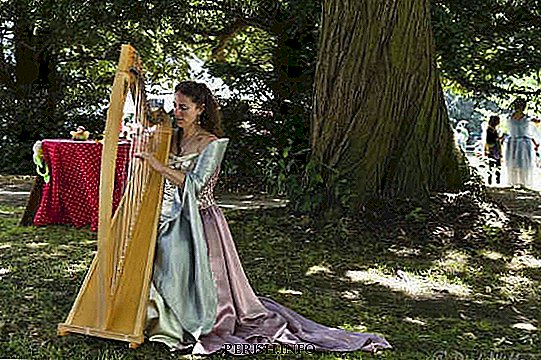
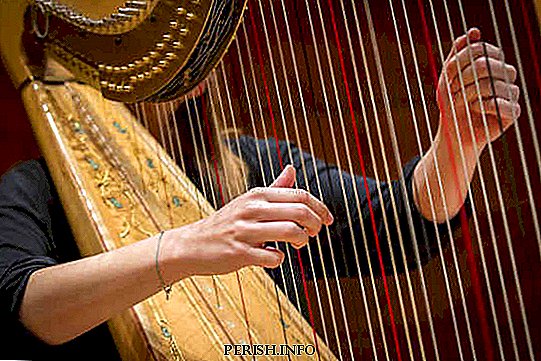
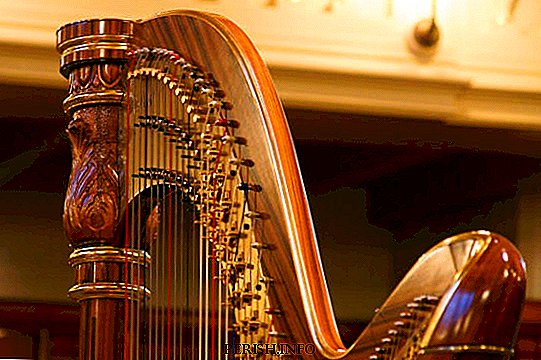
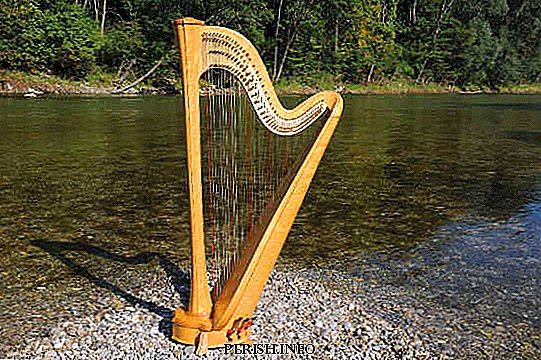
Interesting Facts
- There is a harp for playing 4 hands, 2 performers can play on it at once.
- The longest performance on the harp lasted 25 hours and 34 minutes. Carla Sita, a young American harp player, was only 17 years old when she endured such a long marathon in 2010, performing music of various genres.
- In Russia, the industrial production of harps began in Leningrad, 3 years after the end of the Second World War.
- For many hundreds of years (from the 13th century) this instrument was a symbol of Ireland. Having become a free state, Ireland has not lost its respect for the harp. It is on the coat of arms, presidential and state seals, flags, coins, etc.
- The image of the harp was present on the banners of Britain. For the first time it was struck on the flag by the King of Scotland and England James.
- According to the tale, the Celtic god of abundance, playing the harp, changed the seasons.
- The priests of ancient Egypt conducted rituals involving the harp.
- Until the XIX century, the harp was classified as a purely masculine instruments. However, in 1929, about 70 skeletons of women with gold and silver harps in their hands were found at the excavations of the royal tomb in Ur.
- Scientists believe that due to the energy flow generated by playing the harp, the human body heals. Pythagoras also used the sounds of this instrument to heal diseases. Today, there is a whole direction of alternative medicine - harp therapy, as one of the directions of vibroacoustic therapy.
- There are a lot of long-livers among harpers. For example, the soloist of the Bolshoi Theater, the famous harpist VG Dulova lived 90 years, and her colleague harpist K.K. Saradzheva almost 100 years.
- The most numerous harp ensemble was assembled in Asuncion, Paraguay, on October 26, 2013 for the performance of 2 pieces of music at the festival. 420 harpists from different countries and all ages participated; the youngest was 8 years old and the oldest was 70. All participants were auditioned before performing by professional harpers and teachers.
- In Greece, the sounds of the harp create a ladder connecting heaven and earth, gods and mortals, in Egypt and Syria attributed magical properties and believed that the harp opened the doors to heaven, and therefore decorated them very expensive: covered with gold or silver, inlaid with ivory bone and precious stones. All nations endow this tool with unusual, magical properties. Judging by how beneficial these velvety sounds are on people, these versions become believable.
Works:
R. Glier - Concerto for Harp and Orchestra in E Flat Major (listen)
W.Mozart - Concerto for flute, harp and orchestra in C major (listen)
C. Debussy - Concert for harp and orchestra (listen)
Design
The device is quite simple: a triangular frame with an elegant curve and a series of strings stretched across it. The number of strings of modern harps varies from 40 to 47. Musical instrument weighs about 30 kgbut this does not prevent him from remaining refined and refined.
The frame consists of several parts:
- Resonant casing with rounding down.
- Deca with solid rail.
- Frame with pegs for fastening strings.
- Front timber in the form of a straight column.
- The basis (in some models of a leg or a support).
The pedal harp has a mechanism for changing the pitch of 46 strings. The body is made of wood or metal. At the same time decorated with carvings, gilding, decorative elements. For convenience of reference, the notes “to” at the beginning of each octave are colored red, the notes “fa” are black or blue.
Manufacturers: Aoyama (Japan), Camac (France), Horngacher (Germany), Lyon & Healy (USA), Salvi (Italy), Thurau-Harfenmanufaktur (Germany).
Varieties
The classification of this tool is extremely simple; separation exists by the presence or absence of pedals, as well as by size. There are main types and their categories:
- Pedal harp. A professional instrument that can also be electric, equipped with pickups. It features a pedal mechanism of 7 pedals. Weight 30-50 kg. Height up to 2 meters.
- Leversa harp. This variety can be of different sizes. The number of strings ranges from 22 to 44. Weight varies from 5 to 15 kg. The pedal mechanism is replaced by upper levers-levers.
- Knee harp, Irish or Celtic. Deprived of the ability to take bass, has from 12 to 22 strings. It weighs no more than 5 kg.
Story
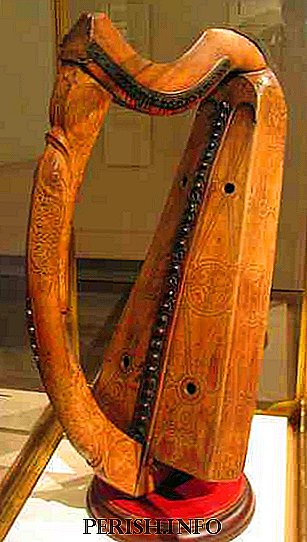
Regarding the appearance of the harp, they make legends and parables. It is considered to be the progenitor of this instrument wooden bow, the stretched string of which publishes the sound, and the ornate contour resembles the bends of the harp. It is found at the excavations of ancient Sumerian settlements, which suggests that the harp appeared at the dawn of the evolution of the human race.
Similar tools are emerging in African tribes, ancient Egypt, Greece, and the Roman Empire. They were decorated with jewels, added elements of ivory, gold, silver. In the Golden Age on this instrument mainly performed church works. The music for them was composed by monks.
In Europe, strolling artists played harps from the 8th century, using small-sized instruments. Large varieties spread in the XVI-XVII centuries. People tried to expand the range of the tool and applied various transformations and additions. The harp began to be included in choral and orchestral performances. Pedals, allowing to give it a large range, came up with J. Hochbruker in 1720, continuing the idea of using regulatory keys, which arose in 1660. The prototype of the modern harp was created by Sebastian Erar. The widespread use of this magical instrument by Russian music lovers began in the 18th century.

Leave Your Comment